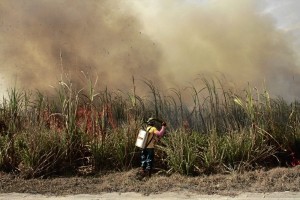Unpaid rents seen in Luisita farm burning

SEVERAL sugar farms in Hacienda Luisita are being burned as punishment for planters who don’t pay lease to farm workers. E.I. REYMOND T. OREJAS/INQUIRER CENTRAL LUZON
TARLAC CITY—At least 200 hectares of sugarcane farms in Hacienda Luisita have been burned allegedly by farm workers angry over the failure of their tenants to pay for the use of the farms at the end of the current cropping season, a farm workers’ leader here said.
Lito Bais, chair of the Alyansa ng Manggagawang Bukid sa Asyenda Luisita (Ambala), said the cases were reported in villages in Tarlac City and Concepcion town. He said Ambala does not encourage or lead the reprisal.
Some farm workers, who have staked claims over lands since 2005, rent out their farms as they wait for the agrarian dispute to end in the sugar estate owned by the family of President Benigno Aquino III, Bais said.
The lease obligations or fees are known here as arriendo.
“The people are angry because the financiers or the planters [who rented their farms] have not paid them,” he said.
On Wednesday, the Inquirer saw a burning sugarcane farm in Barangay (village) Mapalaqsiao in Tarlac City.
In Barangay Parang in nearby Concepcion, at least eight hectares planted by a nephew of Mayor Noel Villanueva have been torched. Workers helped put out the fire, quickly cutting canes that could still be saved.
Villanueva, chair of the Association of Sugar Planters in Central Luzon (Asucal), did not reply to calls and text messages inquiring about the burning.
Romy Lejano, head of the Tarlac-wide Central Azucarera de Tarlac Planters Association, said the burning of canes “could be intentional inside Hacienda Luisita.” He did not give details.
Through arriendo, sugar planters pay P10,000 every year per hectare of farm.
“With no farm operations since 2005, many [farm workers-beneficiaries] asked management if they can use certain parcels to plant crops for sustenance,” lawyer Antonio Ligon, spokesperson of the Hacienda Luisita Inc. (HLI), said to explain how the arriendo system started.
He said no charges are collected by HLI, the company formed in 1989 to handle the stock distribution option (SDO) as a form of agrarian reform at the Cojuangco family-owned plantation.
The Supreme Court in April 2012 upheld the 2005 decision of the Presidential Agrarian Reform Council to scrap the SDO and to distribute 4,915 ha out of the estate’s 6,443 ha.
“At that time, they know they will stop planting if HLI has a need for the land. Then came the SC decision. [There’s] no more HLI control over the agricultural land,” Ligon said.
Lejano said members of his group and Asucal grow sugarcane on some 3,000 ha in Luisita. This is 16 percent of the 18,000 ha of sugarcane farms in Tarlac for this season, he said.
Luisita lands covered by arriendo are 90 percent of CARP-covered areas in the estate, an estimate shared by Noel Mallari, head of the Original 1989 Farmworkers. Tonette Orejas, Inquirer Central Luzon














